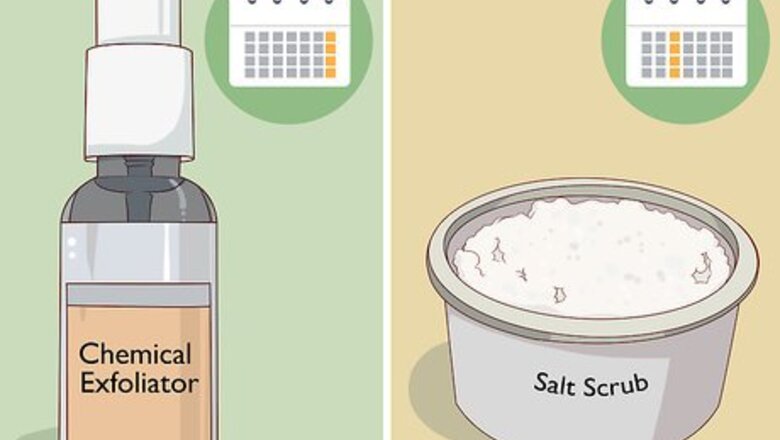
views
- If you have normal or combination skin, use a manual exfoliator. If you have oily or dry skin, try a chemical exfoliator.
- To exfoliate your face, wet your skin and apply the exfoliator in circular motions. Rinse your face and pat your skin dry before using a moisturizer.
- To exfoliate your body, wet your skin in the shower and use a scrub or a body wash. Focus on your feet, elbows, and hands where dry skin tends to build up.
- Exfoliate 2 to 3 times a week, or less often if your skin is easily irritated.
Picking the Right Exfoliator for Your Face

For normal or combination skin: Swap between a chemical and manual exfoliator. Your skin should tolerate most exfoliators, but it might get irritated if you use a manual scrub too often. For best results, try a chemical and manual exfoliator, but use them on different days. This will help you get the benefits of both without stressing your skin. Try not to use an exfoliator with harsh ingredients, like alcohol. You can find your skin type by pressing a piece of tissue against your face. If the tissue has dry flakes of skin on it, you have dry skin. If the tissue has a thin layer of oil on it, you have oily skin. If the tissue has neither, you have normal skin.
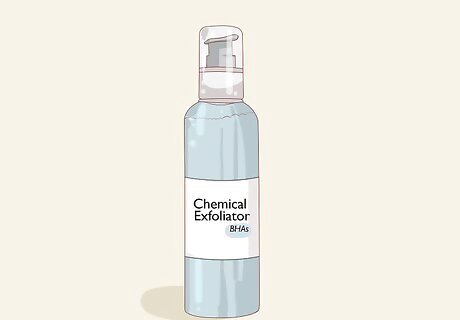
For oily skin: apply a strong chemical exfoliator. Some chemical exfoliators are stronger than others. Choose an exfoliator that has BHAs listed on the label or a high percentage of AHAs. You will likely be able to exfoliate 3 times a week if you have oily skin. Stick to a gentle exfoliator if you have dark skin or are prone to dark spots. Some exfoliators may damage your skin and make your skin look uneven. Alpha hydroxy acids (AHAs) and beta hydroxy acids (BHAs) both help dissolve and remove the dead layer of skin from your face.
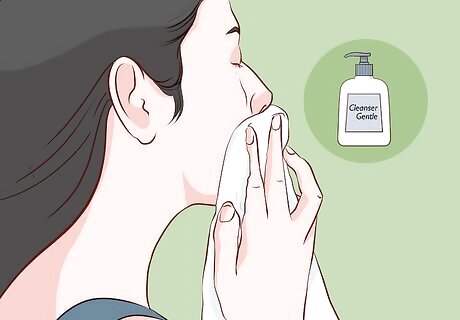
For dry, sensitive, or acne-prone skin: use a washcloth and chemical exfoliator. Look for a mild chemical exfoliator, like glycolic acid. Apply it to a washcloth for more exfoliation. Then, gently scrub your face once or twice a week to remove your dead skin cells. Glycolic acid is a type of AHA that’s derived from sugar cane. It helps create a “peeling” effect on your skin to remove old, dead skin flakes. If your skin gets irritated, apply the product with your fingers instead of a washcloth.
Exfoliating Your Face

Cleanse your skin, then apply your exfoliator in a circular motion. Wash your face with a mild cleanser, then rinse the cleanser off your skin. Wet your face with lukewarm water, then put a quarter-size amount of your exfoliator or scrub on your fingertips. Then, rub it across your face with circular motions to exfoliate your face. Massage your entire face with the exfoliator for about 30 seconds to 1 minute. Try not to apply too much product while you exfoliate. Too much product can irritate your skin, which counteracts the benefits of exfoliation. Don't be too aggressive when you apply the exfoliator. While it can be tempting to rub and press the product into your skin, rubbing too hard can irritate your face.
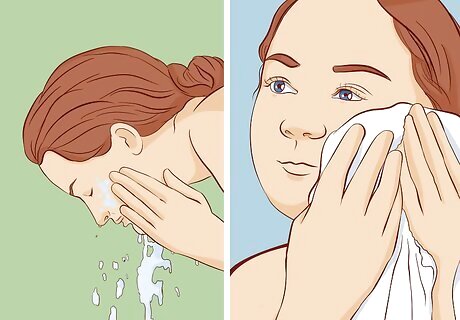
Rinse off the exfoliator with lukewarm water and pat your face dry. Splash the water over your face until all of the product is removed. Then, blot your face dry using a soft, clean towel. Your skin will be extra sensitive after exfoliating. Be sure to pat your skin dry gently instead of rubbing it roughly. If you used a scrub, make sure that you don’t have any granules in your hair line or stuck on your skin, since they can clog your pores.
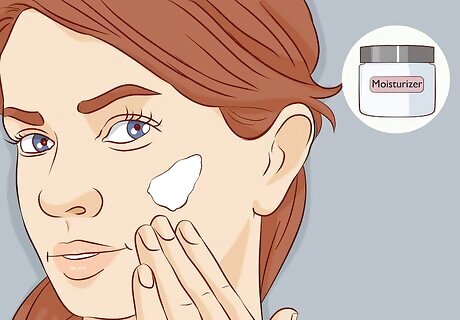
Apply moisturizer to your face to soothe your skin. Your skin might feel a little dry or tight after you exfoliate, so it’s best to moisturize your skin. Use facial lotion immediately after you exfoliate to add moisture back to your skin. Choose a moisturizer that’s formulated for your skin type: for dry skin, use a thick lotion, and for oily or acne-prone skin, use an oil-free lotion. Then, massage about a dime-sized amount of it into your skin. If you use a face serum, apply the serum before you use your moisturizer.

Exfoliate your face 2 to 3 times per week. Your skin will look its best if you exfoliate it regularly. At a minimum, it’s best to exfoliate your skin twice a week. If your skin tolerates it well, exfoliate 3 times per week. If you have sensitive skin, you may only be able to exfoliate once a week. Introduce exfoliation into your routine slowly, and see how your skin reacts. If it tolerates exfoliation (meaning it doesn’t get irritated or red), increase the amount that you exfoliate per week. The best time of day to exfoliate is in the morning. Your skin renews itself at night, so the morning is the best time to scrub away your dead skin cells.
Exfoliating Your Body
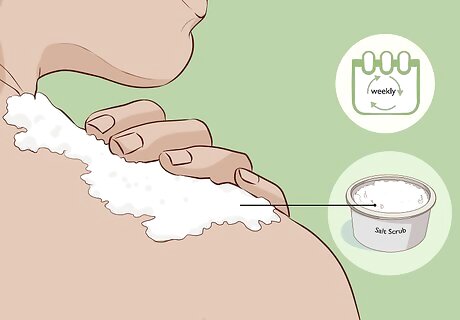
Exfoliate with a sugar or salt scrub weekly to get smooth skin. If you want your skin to be really soft and smooth, use a manual exfoliator once a week to improve your skin. Wet your skin, then massage the scrub into your body before you shower. Start at your shoulders, then rub the exfoliator into your skin down to your toes. Pay special attention to your elbows, knees, and ankles where skin tends to build up. If you don’t use an exfoliating body wash, it’s okay to use a body scrub twice a week, if you like. You can purchase a commercial body scrub or make your own. For a simple body scrub, combine equal parts brown sugar or salt with coconut oil, almond oil, or sweet almond oil. EXPERT TIP Dev Murphy, MA Dev Murphy, MA wikiHow Staff Writer Dev Murphy is a wikiHow Staff Writer with experience working as a teacher, ghostwriter, copyeditor, and illustrator. She loves writing how-to articles because she loves learning new things and because she believes knowledge should be free and accessible to the world. Dev's creative writing and visual art have been featured in many venues online and in print. When she is not writing for wikiHow, she is drawing pictures, making perfume, or writing hybrid poems. Dev earned her MA in English Literature from Ohio University in 2017. She lives in Pittsburgh with her cat, Nick. Dev Murphy, MA Dev Murphy, MA wikiHow Staff Writer "Looking for a body scrub that won't irritate or dry out your skin? Tree Hut sugar scrubs are my go-to: they're packed with shea butter and soothing oils to keep your skin soft and moisturized, and they come in a variety of fragrances that all smell incredible. (My favorite is Moroccan Rose!)"

Use short, light strokes if you use a dry brush or sponge. A brush or scrub allows you to easily exfoliate your skin without a product. Use your brush or sponge daily before you shower while your skin is dry. Start at your shoulders and work your way down to your feet. Move the brush or sponge across your skin in short, light strokes to remove your dead skin cells. You may want to use a dry brush if you have oily or normal skin. Dry brushing isn’t recommended for people with sensitive or especially dry skin, since the brush might irritate you more.
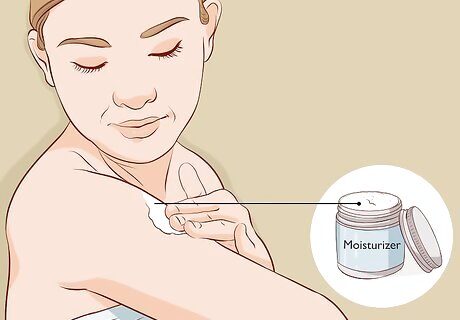
Apply moisturizer after you exfoliate to nourish your skin. It’s normal for your skin to feel dry or itchy after you exfoliate. Fortunately, you can relieve this by applying a body lotion or cream. Slather your favorite moisturizer over your body as soon as you get out of the shower. Use about a shot glass of body lotion or cream to cover your entire body.


















Comments
0 comment